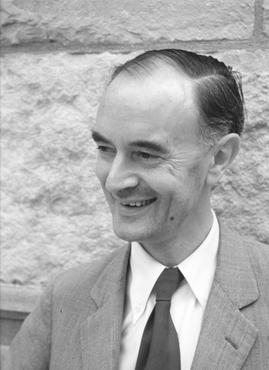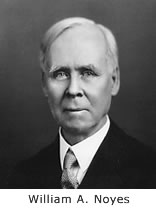Related Research Articles

Waldo Lonsbury Semon was an American inventor born in Demopolis, Alabama. He is credited with inventing methods for making polyvinyl chloride useful.

Wallace Hume Carothers was an American chemist, inventor, and the leader of organic chemistry at DuPont, who was credited with the invention of nylon.

James Bryant Conant was an American chemist, a transformative President of Harvard University, and the first U.S. Ambassador to West Germany. Conant obtained a Ph.D. in chemistry from Harvard in 1916.

Percy Lavon Julian was an American research chemist and a pioneer in the chemical synthesis of medicinal drugs from plants. Julian was the first person to synthesize the natural product physostigmine, and a pioneer in industrial large-scale chemical synthesis of the human hormones progesterone and testosterone from plant sterols such as stigmasterol and sitosterol. His work laid the foundation for the steroid drug industry's production of cortisone, other corticosteroids, and artificial hormones that led to birth control pills.

Sir Christopher Kelk Ingold was a British chemist based in Leeds and London. His groundbreaking work in the 1920s and 1930s on reaction mechanisms and the electronic structure of organic compounds was responsible for the introduction into mainstream chemistry of concepts such as nucleophile, electrophile, inductive and resonance effects, and such descriptors as SN1, SN2, E1, and E2. He also was a co-author of the Cahn–Ingold–Prelog priority rules. Ingold is regarded as one of the chief pioneers of physical organic chemistry.

Roger Adams was an American organic chemist who developed the eponymous Adams' catalyst, and helped determine the composition of natural substances such as complex vegetable oils and plant alkaloids. He isolated and identified CBD in 1940. As head of the Chemistry department at the University of Illinois from 1926 to 1954, he influenced graduate education in America, taught over 250 Ph.D. students and postgraduate students, and served in military science during World War I and World War II.

William Albert Noyes was an American analytical and organic chemist. He made pioneering determinations of atomic weights, chaired the chemistry department at the University of Illinois Urbana–Champaign from 1907 to 1926, was the founder and editor of several important chemical journals, and received the American Chemical Society's highest award, the Priestley Medal, in 1935.
Carl Shipp "Speed" Marvel was an American chemist who specialized in polymer chemistry. He made important contributions to U.S. synthetic rubber program during World War II, and later worked at developing polybenzimidazoles, temperature-resistant polymers that are used in the aerospace industry, in fire-fighting equipment, and as a replacement for asbestos. He has been described as "one of the world's outstanding organic chemists" and received numerous awards, including the 1956 Priestley Medal and the 1986 National Medal of Science, presented by President Ronald Reagan.
Physical organic chemistry, a term coined by Louis Hammett in 1940, refers to a discipline of organic chemistry that focuses on the relationship between chemical structures and reactivity, in particular, applying experimental tools of physical chemistry to the study of organic molecules. Specific focal points of study include the rates of organic reactions, the relative chemical stabilities of the starting materials, reactive intermediates, transition states, and products of chemical reactions, and non-covalent aspects of solvation and molecular interactions that influence chemical reactivity. Such studies provide theoretical and practical frameworks to understand how changes in structure in solution or solid-state contexts impact reaction mechanism and rate for each organic reaction of interest.
Charon Robin Ganellin FRS is a British medicinal chemist, and Emeritus Smith Kline and French Professor of Medicinal Chemistry, at University College London.

The Charles Goodyear Medal is the highest honor conferred by the American Chemical Society, Rubber Division. Established in 1941, the award is named after Charles Goodyear, the discoverer of vulcanization, and consists of a gold medal, a framed certificate and prize money. The medal honors individuals for "outstanding invention, innovation, or development which has resulted in a significant change or contribution to the nature of the rubber industry". Awardees give a lecture at an ACS Rubber Division meeting, and publish a review of their work in the society's scientific journal Rubber Chemistry and Technology.
Dr. Benjamin St. John Garvey (1900–1973) was a chemist at BF Goodrich who worked under Waldo L. Semon on the development of synthetic rubber, contributed to understanding of vulcanization, and developed early techniques for small scale evaluation of rubbers. In particular, he was the inventor of the Garvey die for evaluating the extrusion quality of rubber compounds.
Harry Linn Fisher was the 69th national president of the American Chemical Society, and an authority on the chemistry of vulcanization. Fisher was the author of four popular books on the chemistry and technology of rubber, and the holder of 50 patents.
Herman Pines was a Russian Empire–born American chemist best known for his work with Vladimir Ipatieff on the catalytic conversion of high-octane aviation fuel. Because of his scientific contributions, new processes were developed for the isomerization of paraffins, the alkylation of aromatic compounds, and base-catalyzed organic reactions.

Sylvia Marie Stoesser, was an American chemist. She was the first woman to be employed as a chemist at Dow Chemical Company. During her time at Dow, she made a number of major contributions, holding more than two dozen patents as a result of her research.
Anthony William Czarnik is an American chemist and inventor. He is best known for pioneering studies in the field of fluorescent chemosensors and co-founding Illumina, Inc., a biotechnology company in San Diego. Czarnik was also the founding editor of ACS Combinatorial Science. He currently serves as an adjunct visiting professor at the University of Nevada, Reno.
John Henry Wotiz was a Czech-American chemist in the areas of organic chemistry and chemical history.

Vaman Ramachandra Kokatnur was an American chemist of Indian origin. He was an industrial chemist and patented several chemical processes in the USA, Germany, England, France, and Canada, particularly the use of catalysts in organic synthesis. Like many Indian immigrants into the US in the period he supported Indian Independence, while considering caste and class hierarchies as necessities in society.
Charles Sundy Schollenberger was an American chemist. He invented the first thermoplastic polyurethane (Estane).
Robert Wesley Layer was a B. F. Goodrich chemist noted for contributions to chemistry of imines and for chemical stabilization of elastomers.
References
- ↑ Harper, Charles A. (2001). Handbook of Materials for Product Design. McGraw-Hill. p. 6.2. ISBN 9780071354066.
- ↑ "Chemical Feats". Rubber & Plastics News. 2000-10-16. Retrieved 27 December 2017.
- ↑ Winkelmann, H. A. (1926). "The present and future of reclaimed rubber". Industrial & Engineering Chemistry. 18 (11): 1163–1168. doi:10.1021/ie50203a018.
- ↑ Winkelmann, H. A. (1952). "Static Exposure Testing of Automotive Compounds-Effect of Compounding Ingredients". Industrial & Engineering Chemistry. 44 (4): 841–850. doi:10.1021/ie50508a041.
- 1 2 "Chem. Eng. News". No. 38 (45), pp 111–129. AMERICAN CHEMICAL SOCIETY. November 7, 1960. doi:10.1021/cen-v038n045.p111.
- ↑ Gurganus, Ray. "Class of Appleton, 1910". Swift County Photos. US Gen Web Project. Retrieved 28 December 2017.
- ↑ Winkelmann, Herbert (May 15, 1919). The determination of organic compounds in low concentrations. University of Illinois.
- ↑ "DR. GEORGE BEAL, CHEMIST 84, DIES". New York Times. January 5, 1972. Retrieved 10 January 2025.